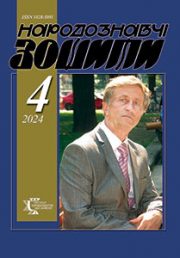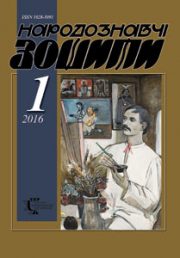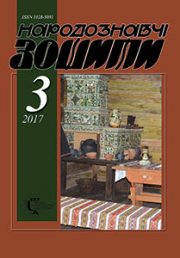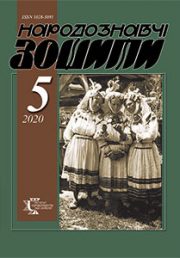The Ethnology Notebooks. 2020. # 6 (156), 1389—1406
УДК 398.8(477)
DOI https://doi.org/10.15407/nz2020.06.1389
Oksana HALAICHUK
- ORCID ID: https://orcid.org/0000-0001-8052-6616
- Ph. D. of Sciences in Philology,
- Researcher of the International Institute
- for Education, Culture and Diaspora Relations
- of Lviv Polytechnic National University
- 32, Stepana Bandery street, 79000, Lviv, Ukraine,
- e-mail: ok_halaychuk@ukr.net
THE RELICTS OF THE CHIVALRY IN THE TRADITIONAL UKRAINIAN WEDDING
Problem statement. The traditional Ukrainian wedding kept the features of all the socio-historical stages of the life of the people. One of these stages is the heroic era before the reign of princes and the period of Kievan Rus’. The article investigates the phenomenons that has survived as a relicts from ancient times of knights of the princely age and who is include in the texts and rites of all phases of the Ukrainian wedding.
Threats, calls to the beginning of the war and battles, overcoming obstacles — we hear these military manifestations in songs and saw in different parts of the wedding ceremony: when the groom visits the bride on Saturday, when on Sunday he goes with the boyars the bride to marry, when he leads the bride to his house and so on.
Most of these phases accompany the rite of redemption as one of the aspects of the realization of a wedding event. The fact that ransom is in almost every phase of the wedding indicates that it was not only an important element in the folk tradition of ancient Ukrainians, but also apology for offending another’s family — for the kidnapping of girl of another’s family in order to marry.
The relevance of this study is due to the need for a deeper study of the traditional wedding ritual of Ukrainians. As a large folklore and ritual complex, the traditional wedding is one of the most valuable layers of the spiritual culture of Ukrainians, and all its components, without exception, retain a number of important historical and cultural information.
The purpose of the publication is to clarify the manifestations of elements of the pre-princely and princely era in the Ukrainian wedding ritual.
The object of our research is a traditional Ukrainian wedding, the subject is relics of knighthood of the princely era, preserved in wedding ceremonies and accompanying folklore texts.
The methodological basis of the work was the research of leading Ukrainian and foreign researchers: Mykola Sumtsov, Khvedor Vovk, Valentyna Borysenko, Alexander Gura and others.
Conclusion. The relicts of the chivalry of the Princedom and pre- Princedom period in the traditional Ukrainian wedding are represented in ritual actions and song texts through the system of wedding ranks, including prince, princess, king, queen, retinue, army, boyars, best man/bridesmaids, svashky (groom’s married sister or female relative), khorunzhyi/ marshalok, scribes, ambassador. The centralrole of a protector and warrior in the bride’s escort if performed by her brother, who takes on the mentioned functions.
The chivalry relic in the wedding drama are military attributes, such as the sword, sable, mace, standard, flag of marshal.
The symbolic meaning of threat, sending to the war, conquering or battle as components of abduction is traceable at the following stages of the wedding event: inviting to the wedding, departure of the fiance with his man to the fiancee on Saturday, departure of the groom with his escort to fetch the bride on Sanday morning, collecting the bride from the parents’ home to the groom’s home, even at the moment of the bride’s arrival at the groom’s home ets.
Keywords: Ukrainian wedding, song, text, rite, chivalry, prince, princess, kidnapping girl for marriage, ransom.
REFERENCES
- Afanasyev, A. (2002). Poetic views of the Slavs on nature. Myths, beliefs and superstitions of the Slavs (Vol. 2). Moskow: Eksmo; SPb: Terra Fantastica [in Russian].
- Baiburin, A., & Levinton, G. (1975). «Prince» and «princess» in Russian wedding magnificence (to the semantics of ritual terms). Russian Philology: Sb. stud. scientific works philol. faculty (Issue IV, pp. 75—76). Tartu [in Russian].
- Borisenko, V.K. (1988). Wedding customs and rites in Ukraine: Historical and ethnographic research. Kyiv: Naukova dumka [in Ukrainian].
- Budzinovsky, V. (1906). Cossack times in folk songs. Lviv [in Ukrainian].
- Verkhovynets, V. (1970). Wedding in the village of Shpychyntsi, Skvyra district, Kyiv province. Wedding (Vol. 1, pp. 220—280). Кyiv: Naukova dumka [in Ukrainian].
- Veselovsky, A. (1940). Historical poetics. Leningrad: Khudozhestvennaya literatura [in Russian].
- Vovk, Khv. (1995). Studies in Ukrainian ethnography and anthropology. Kyiv: Mystetstvo [in Ukrainian].
- Vovk, Khv. (1995). Marriage ritual and rites in Ukraine. Studies in Ukrainian ethnography and anthropology (Pp. 219—323). Кyiv: Mystetstvo [in Ukrainian].
- Halaichuk, V., Pylypchuk, S., & Siletsky, R. (2012). Wedding in the village of Sapanov, Kremenets district, Ternopil region. Visnyk of Lviv National University. The series is historical (Issue 47, pp. 344—365). Lviv: Ivan Franko Lviv National University [in Ukrainian].
- Halaichuk, O. (2015). Humorous wedding songs of the village of Domashiv, Sokal district, Lviv region. Mythology and Folklore, 3—4, 145—155) [in Ukrainian].
- Hrinchenko, B. (1970). Wedding in the village of Lower Syrovatka Sumy district of Kharkiv province. Wedding (Vol. 1, pp. 393—411). Кyiv: Naukova dumka [in Ukrainian].
- Hrushevsky, M., Yaremenko, V.V., & Kononenko, P.P. (1993). History of Ukrainian literature. (Vol. 1). Кyiv: Lybid («Literaturni pamiatky Ukrainy») [in Ukrainian].
- Gura, A. (2012). Marriage and wedding in Slavic folk culture: Semantics and symbols. Moskow: Indrik [in Russian].
- Davydyuk, V. (1997). Ukrainian mysteries in the genetic and functional aspect. Ethnographic notebooks, 4, 231—236) [in Ukrainian].
- Demchenko, I. (1970). Wedding in the town of Monastyryshche, Lipovets district, Kyiv province. Wedding (Vol. 1, pp. 147—219). Кyiv: Naukova dumka [in Ukrainian].
- Denisyuk, I. (2004). Songs from the shores of Lake Turkey: Songs and comments. Lutsk: Nadstyria [in Ukrainian].
- Denisyuk, I. (2004). Tur’s wedding: introductory word. Songs from above the shores of Tur’s Lake (Pp. 5—24). Lutsk: Nadstyria [in Ukrainian].
- Dymnych, N. (1970). Wedding in the village of Kremesh Gorokhiv district. Wedding (Vol. 2, pp. 7—72). Кyiv: Naukova dumka [in Ukrainian].
- Halaichuk, V. (1997). Record in the Olevsky district Zhytomyr region. Аrchivum DCZNKSTK [in Ukrainian].
- Zdorovega, N. (1974). Essays on folk wedding ceremonies in Ukraine. Кyiv: Naukova dumka [in Ukrainian].
- Ivashkiv, V. (2009). Artistic, literary and folklore paradigm of the early work of Panteleimon Kulish. Lviv: Ivan Franko Lviv National University Publishing Center [in Ukrainian].
- Kalinovsky, G. (1970). Description of Ukrainian wedding folk rites. 1777. Wedding (Vol. 1, pp. 68—74). Кyiv: Naukova dumka [in Ukrainian].
- Klymchuk, F. (1999). Traditional wedding of Simonovychi village. Visnyk of Lviv National University. The series is philological (Issue 27: Ukrainian folklore, pp. 185—274). Lviv: LNU Ivan Franko [in Ukrainian].
- Crymsky, A., & Chaban, A.Yu. (2009). Zvenigorod region. Shevchenko’s homeland from the point of view of ethnographic and dialectological: Reproduction from the author’s model of 1930. Cherkasy: Vertical, publisher PE Kondich SG [in Ukrainian].
- Krypyakevych, I. (1936). History of the Ukrainian army (Vol. 1). Lviv: Ivan Tiktor Edition [in Ukrainian].
- Litvinova-Bartosh, P. (1900). Wedding ceremonies and customs in the village Zemlyanka Glukhiv district in Chernihiv. Materials on Ukrainian-Russian ethnology (Vol. 3, p. 94). Lviv [in Ukrainian].
- (1989). Chronicle of the Russian. Translated from the Ipat list by Leonid Makhnovets. Кyiv: Dnipro [in Ukrainian].
- Lozynsky, J. (1992). Ukrainian wedding. Кyiv: Naukova dumka [in Ukrainian].
- Magrytska, I. (2003). Dictionary of wedding vocabulary of Ukrainian East Slobozhansk dialects (Luhansk region). Luhansk: Znannia [in Ukrainian].
- Marchuk, Z. (2005). Genealogy of the Ukrainian wedding. Lutsk: Institute of Cultural Anthropology [in Ukrainian].
- Kharchyshyn, O., Koval, V. (2005). Folk song of the Lviv Zvenyhorodshchyna: collection. Lviv: Ukrpol Publishing House [in Ukrainian].
- Nesen, I. (2005). Wedding ritual of Central Polissya: traditional structure and relic forms (middle of the XIX—XX centuries). Kyiv: Center for the Protection of Cultural Heritage from Emergencies [in Ukrainian].
- Levitsky, Simeon (Ed.). (1972). Description of weddings and wedding ceremonies of Ukrainian Little Russians (in Boguslav region). Folk art and ethnography, 2, 98) [in Ukrainian].
- Philipenko, M. (1969). Traces of tribal organization in the wedding customs of the Slavic peoples. Soviet Slavonic Studies: Proceedings of the IV Conference of Slavic Historians (Pp. 642—643). Minsk [in Russian].
- Pravdyuk, O. (1970). People’s wedding in Ukraine. Wedding (Vol. 1, pp. 412—440). Кyiv: Naukova dumka [in Ukrainian].
- Roshkevych, O., & Franko, I, (1970). Wedding rites and songs of the Russian people in the village of Lolin, Stryi district. 1886. Wedding (Vol. 2, pp. 73—124). Кyiv: Naukova dumka [in Ukrainian].
- Sventsitsky, I. (1933). Christmas in the march of the ages. Lviv [in Ukrainian].
- Skaletsky, R. (1970). Wedding in the village of Mykhailivka, Bershad district, Vinnytsia region. Wedding (Vol. 1, pp. 281—354). Кyiv: Naukova dumka [in Ukrainian].
- Sumtsov, N. (1996). On wedding ceremonies, mostly Russian. Symbols of Slavic rites. Selected works (Pp. 6—157). Moscow: Eastern Literature [in Russian].
- Dey, O.I. (1974). Ukrainian folk songs in the records of Zorian Dolenga-Khodakovsky (from Galicia, Volhynia, Podillya, Dnieper and Polissya). Кyiv: Naukova dumka [in Ukrainian].
- (1982). Ukrainian folk songs in the records of Sofia Tobilevych (1982). (P. 72). Кyiv: Naukova dumka [in Ukrainian].
- Dey, O.I. (1983). Folklore records of Marko Vovchоk and Opanas Markovych. Кyiv: Naukova dumka [in Ukrainian].
- Khibeba, N. (2008). Wedding agents in Boyko and Polissya dialects: ethnolinguistic aspect. Volyn-Zhytomyrshchyna (Issue 18, pp. 75—89) [in Ukrainian].
- Chaban, I. (1970). Wedding in the Sokal region. Wedding (Vol. 2, pp. 125—182). Кyiv: Naukova dumka [in Ukrainian].
- Chubynsky, P. (1970). Wedding in the village of Boryspil, Pereyaslav district, Poltava province. Wedding (Vol. 1, pp. 81—146). Кyiv: Naukova dumka [in Ukrainian].
- Chubynsky, P. (1995). Wisdom of the ages: Ukrainian ethnography in the creative heritage of Pavel Chubynsky (Vol. 2). Kyiv: Mystetstvo [in Ukrainian].







